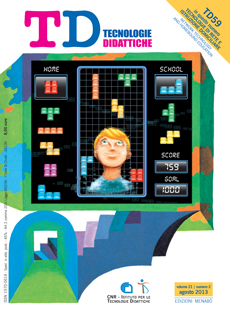WISEland , un ambiente formativo online sulla didattica domiciliare
Contenuto principale dell'articolo
Abstract
Dettagli dell'articolo
Gli autori che pubblicano su questa rivista accettano le seguenti condizioni:
- Gli autori mantengono i diritti sulla loro opera e cedono alla rivista il diritto di prima pubblicazione dell'opera, contemporaneamente licenziata sotto una Licenza Creative Commons CC BY 4.0 Attribution 4.0 International License.
- Gli autori possono aderire ad altri accordi di licenza non esclusiva per la distribuzione della versione dell'opera pubblicata (es. depositarla in un archivio istituzionale o pubblicarla in una monografia), a patto di indicare che la prima pubblicazione è avvenuta su questa rivista.
- Gli autori possono diffondere la loro opera online (es. in repository istituzionali o nel loro sito web) prima e durante il processo di submission, poiché può portare a scambi produttivi e aumentare le citazioni dell'opera pubblicata (Vedi The effect of Open Access).
Riferimenti bibliografici
Benigno V., Repetto M. (2012). Homebound Education e istruzione scolastica: l’indagine nazionale sull’uso delle TIC nell’istruzione domiciliare. In G. Trentin (ed.). Reti e inclusione socio-educativa. Il sistema di supporto WISE . Franco Angeli: Milano, pp. 31-53.
Dettori G., Giannetti T., Paiva A., Vaz A. (eds.) (2006). Technology-Mediated Narrative Environments for Learning. Rotterdam, Taipei: Sense Publishers, Kaleidoscope.
Fazioli M.P. (2009). Effects of personalized narration on motivation in a web-based environment. Cambridge, UK: ProQuest publication.
Gunawardena C.N. (2005). Social presence theory and implications for interaction collaborative learning in computer conferences. International Journal of Educational Telecommunications, 1 (2-3), pp. 147-166.
Huang H., Rauch U., Liaw S. (2010). Investigatin learners’ attitudes toward virtual reality learning environments: Based on a constructivist approach. Computer & Education,55 (3), pp. 1171-1182.
Kalyuga S. (2007). Expertise reversal effect and its implications for learner-tailored instruction. Educational Psychology Review , 19, pp. 509-539.
Knowles M.S., Holton E.F., Swanson R.A. (1998). A theory of adult learning: andragogy. In The adult learner: the definitive classic in adult education and human resource development (5th ed.). Woburn, MA, USA: Butterworth Heinemann, pp. 35-72.
Mayer R.E. (2005). Principles of multimedia learning based on social cues: Personalization, voice, and image principles. In R. E. Mayer (ed.)., The Cambridge handbook of multimedia learning . New York, USA: Cambridge University Press, pp. 201-212.
Mandernach B. (2009). Effect of instructor-personalized multimedia in the online classroom. The International Review of Research in Open and Distance Learning , 10 (3) http://www.irrodl.org/index.php/irrodl/article/ view/606/1263 (ultima consultazione 30.05.2013).
Newmaster S., Lacroix C. A., Roosenboom C. (2006). Authentic learning as a mechanism for learner centeredness. International Journal of Learning, 13 (6), pp. 103-112.
Repetto M., Benigno V. (2012). WISEland: il percorso formativo sull’istruzione domiciliare. In G. Trentin (ed.). Reti e inclusione socio-educativa. Il sistema di supporto WISE . Milano : Franco Angeli, pp.213-241.
Repetto M., Bernava L. (2013). Un ambiente di au- toformazione sulla didattica domiciliare. Education 2.0 http://www.educationduepuntozero.it/tecnologie-e-ambienti-di-apprendimento/ambiente-autoformazione-didattica-domiciliare- 4062467594.shtml (ultima consultazione 21.02.2013).
Schworm S., Stiller K.D (2012). Does personalization matter? The role of social cues in instructional explanations. Intelligent Decision Technologies, Special Issue on Multimedia/Multimodal Human-Computer Interaction in Knowledge-based Environments , 6, pp. 105-111.

